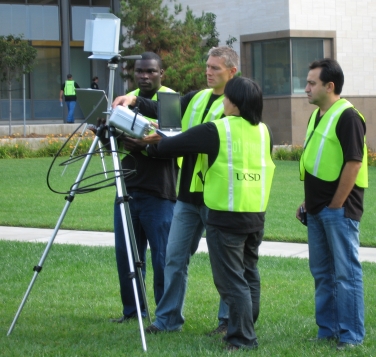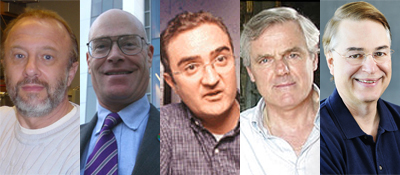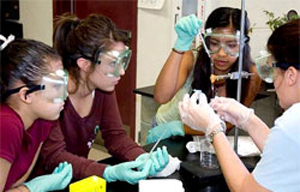Calit2 Participates in First-Ever San Diego Science Festival
Researchers to Inspire Students, Put San Diego on the Science Map
San Diego, March 2, 2009 -- Top researchers will fan out to San Diego high schools to excite students about careers in science, and engineers will deploy wireless infrastructure in Balboa Park for a day-long expo. Those are just two of the activities that will bring the knowhow of the UC San Diego division of the California Institute for Telecommunications and Information Technology (Calit2) to the region's upcoming science mega-event.
|
Calit2 will participate in many of the events. “We made a commitment early on to participate in the Festival because it will expose thousand of students to the very tangible results of the institute’s interdisciplinary research,” says Ramesh Rao, director of the UCSD division of Calit2. “This is also a great opportunity to showcase our technologies to the wider San Diego community.”
“Calit2 has been incredibly supportive as we’ve been planning the festival,” says Festival organizer Lawrence Bock, a long-time San Diego venture capitalist.
The month-long festival will culminate with an Expo Day on April 4 in Balboa Park . Roughly 30 exhibits (including Calit2’s) and related activities will take place both indoors and outdoors, and the park’s existing wireless infrastructure does not cover many of the Expo areas. Organizers asked for Calit2’s help in providing high-speed Wi-Fi connectivity for exhibitors, and Calit2 responded in the affirmative.
|
The research will also include environmental monitoring: Jacobs School of Engineering professor Jan Kleissl will deploy wireless sensors to measure environmental parameters at each wireless access point in the CalMesh network.
Data transmitted over the CalMesh network will get to and from the Internet via two line-of-sight backhauls from the roof of the Natural History Museum: one on top of the Meridian Hotel downtown provided by Skyriver Communications Inc. (a longtime partner of Calit2 on previous deployments requiring broadband access); the other by the NSF-funded High Performance Wireless Research and Education Network (HPWREN), which has a facility at the UCSD Medical Center in Hillcrest.
Taken together, the connectivity of the two base stations could top 30 Megabits per second (Skyriver 12 Mbps at 5.4 GHz, and HPWREN 20 Mbps at 4.9 GHz).
The CalMesh network will be available to designated exhibitors (not the public). Calit2 itself will be a user of the ad hoc network in Balboa Park . The Calit2 tent will provide demos of various visualization technologies, including a mobile touchscreen kiosk based on Calit2’s Gizmo technology, the new California Traffic Report app for the iPhone, as well as other devices, software and systems developed at Calit2.
|
- Physics professor Ivan Schuller, co-founder of Calit2’s Nano3 cleanroom facility and one of the 100 most-read and cited physicists in the world (out of 500,000), is set to visit three schools: Language Academy on March 5, Cathedral Catholic High on March 12, and Torrey Pines High on March 25;
- Robert Hecht-Nielsen, director of the Confabulation Neuroscience Lab at Calit2, speaks to students at Oak Crest High on March 10;
- Javier Movellan, co-director of the Machine Perception Lab, goes to Sacred Heart Coronado on March 12 and Hilltop High on March 26;
- Maurizio Seracini, director of Calit2’s Center of Interdiscplinary Science for Art, Architecture and Archaeology (CISA3), will visit Chula Vista High on March 27;
- and
- Calit2 director Larry Smarr , a professor in computer science and engineering in the Jacobs School of Engineering, will visit Patrick Henry High on March 30.
Other Calit2-affiliated faculty members from UC San Diego who will give Nifty Fifty talks include Jacobs School Dean Frieder Seible, San Diego Supercomputer Center Director Fran Berman, Jacobs School Associate Dean Jeanne Ferrante, Chemistry and Biochemistry professor Michael Sailor, Jacobs School professor Jan Talbot, and Shu Chien, Director of the new Institute of Engineering in Medicine. The scientists will talk about their trials and triumphs as scientists and help connect students with real-world applications of science.
|
On March 26, Calit2 will also host an event when Festival organizers say ‘thank you’ to the many corporations and other institutions that agreed to make the event happen, including principal sponsor Lockheed Martin, Qualcomm, Invitrogen, General Atomics and many others. Last week, Lockheed Martin became the Festival’s lead sponsor with a $100,000 donation – bringing total donations so far to approximately $650,000.
Among other UC San Diego events during the month-long Festival, the Department of Nanoengineering – based in Atkinson Hall – will host a day-long program April 1 on the UCSD campus. Dubbed “Small Wonders,” the program for 175 high school students from across San Diego will focus on new materials made possible by advances in nanoengineering and materials science.“Through interaction with such scientists and by attending the Festival, it is hoped that students will be shown clear connections between how science-based academic studies can be applied to solve real-life problems and lead to enriching careers,” says Jeremy Babendure, a Festival Director and Founding Director of BioBridge, a hands-on science education outreach program at UCSD which helped serve as a model for Science Festival activities. “We hope that such motivation will help to increase the number of American students in the dynamic science and technology fields.”
Other festival programs include “Lunch with a Laureate,” which will bring eight Nobel Prize winners to high schools and community colleges for lunchtime discussions. Teacher training programs will also offer opportunities for teachers to obtain continuing-education credit from UCSD Extension for volunteering at many of the events.
Media Contacts
Doug Ramsey/Calit2, 858-822-5825, dramsey@ucsd.edu or Don Williams/Sneaker Academy, 760-707-4589, dw@sneakeracademy.com
Related Links
San Diego Science Festival
Small Wonders
CalMesh




